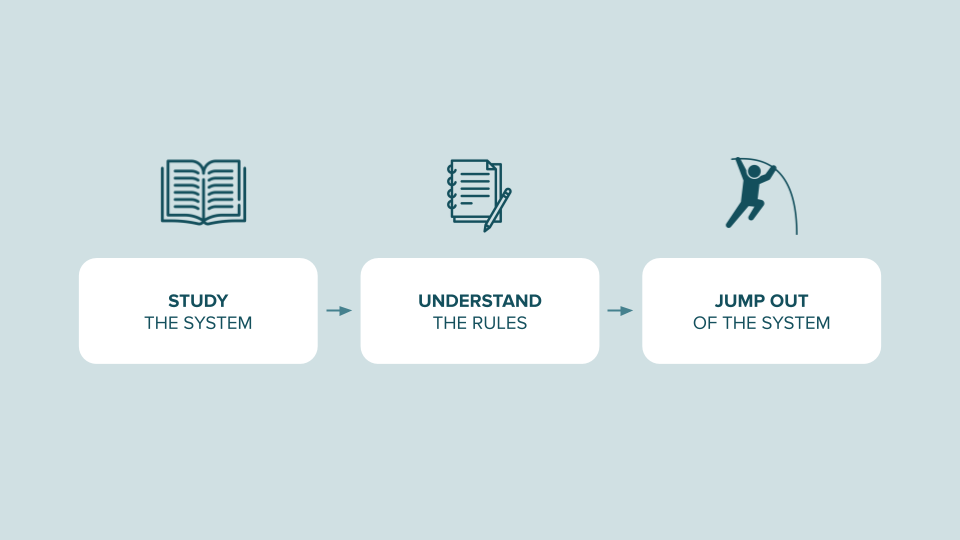“Constraints breed creativity” is such a popular principle, it has become a design trope. Think outside the box, they say. Rather than just thinking outside the box, “jootsing” is about destroying the box or completely ignoring its existence. The term was coined by Douglas Hofstadter, an American scholar of cognitive science, physics, and comparative literature. Jootsing stands for “Jumping Out Of The System”—a method to foster creativity in science, philosophy, and the arts.
However simple or complex, all systems have rules. With jootsing, a system’s rules can be used as a starting point to work against. As philosopher, writer, and cognitive scientist Daniel Dennett explains: “Being creative is not just a matter of casting about for something novel—anybody can do that, since novelty can be found in any random juxtaposition of stuff—but of making the novelty jump out of some system, a system that has become somewhat established, for good reasons (…) It helps to know the tradition if you want to subvert it. That’s why so few dabblers or novices succeed in coming up with anything truly creative.”
Because it is based on an intimate knowledge of the rules governing a system, jootsing is not a magic bullet; instead, it requires a lot of hard work. But if you are willing to put the work in, it can help generate some truly innovative ideas.
The principles of jootsing
Jumping out of the system requires understanding the system. While thinking outside the box has become a metaphor for unconventional thinking, it says nothing about how much people know about the inside of the box.
Ignorance or a lucky mistake can both lead to thinking outside the box. A three-year old child could think outside the box by not knowing about the box in the first place. On the other hand, the concept of jootsing puts the emphasis on studying the rules of the system before you can break them.
You can also see jootsing as a much more extreme version of thinking outside the box. When thinking outside the box, we are still somehow constrained by the box. We still think around the box. Jootsing forces us to completely break away from the box, to create within a space that violates the fundamental characteristics of the box.
Jootsing is not about breaking the rules for the sake of breaking the rules. Sometimes, breaking the rules may not lead to any creative ideas. And sometimes, breaking the rules may not be the right thing to do—as in, it may not lead to an ethical decision. An innovative yet unethical idea is rarely worth pursuing.
You may not have noticed, but jootsing is all around you, the result of its process apparent in some of the most innovative modern products you use everyday. Here are some examples of jootsing:
- “You need water to use shampoo” → Dry shampoo
- “You need a license to drive a taxi” → Uber
- “You need alcohol to make cocktails” → Mocktails
As you can see, the idea is to start from a seemingly unbreakable rule, and then… To proceed to break it. Again—it may seem simple, but it’s not that easy. However, jootsing can lead to uniquely creative concepts. As Eliezer Yudkowsky puts it: “The most amazing acts of creativity are those that violate the rules that we would least expect to be violated.”
How to practice the art of jootsing
Jootsing consists of only three steps, but each requires quite a bit of work. The more complex the system you want to jump out from, the more work will be required. Here are the three steps:
- Study the system. Instead of aiming for a superficial understanding, go deep in your study of the system. Read all the fundamental books, articles, and research papers that explore your system of interest. Contact experts, ask questions, become familiar with relevant policies. Use the Feynman technique to make sure you actually understand what you are studying.
- Understand the rules. You cannot break the rules you are not familiar with. While you study the system, make sure to take notes as to what rules are commonly considered as unbreakable. You can even rate these rules based on how unbreakable they seem to be. The harder to break, the more interesting.
- Jump out of the system. Take the rules one by one, and think of ways to break each of them. You won’t be able to perform that step if you haven’t spent time understanding the system and laying down its rules. Again, in the words of Daniel Dennett: “It helps to know the tradition if you want to subvert it. That’s why so few dabblers or novices succeed in coming up with anything truly creative.”
You will find that some rules are truly impossible to break, at least with your current skills, or humanity’s current knowledge. Some iterations may lead you to less-than-exciting concepts, which won’t be worth pursuing. But yet other attempts may be the seed of a truly unique, innovative idea.
Jootsing doesn’t have to be limited to your own thinking. If you are an educator, you can also apply the art of jootsing to the way you teach your students. Instead of just reprimanding students who tend to break the rules, ask them why they think the rule exists, and why they think it should be broken. What other rules do they think should replace the existing ones, and why? Encourage them to think about rules in a critical but constructive way.
“Creativity, that ardently sought but only rarely found virtue, often is a heretofore unimagined violation of the rules of the system from which it springs,” said Daniel Denett. Jootsing—jumping out of the system—is a way to encourage such violation of the rules of the system from which creativity will spring.
P.S. Another alternative to thinking outside the box is to think inside the box 🙂

